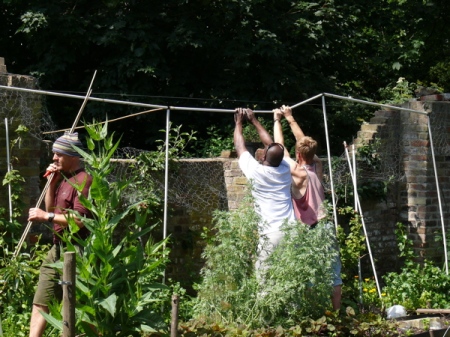A wonderful day at Allens Gardens today. The sun is out and with it comes loads of volunteers and visitors to the site. This means that while I clear a bed of rocket, that has flowered, to make way for mizuna, all around me chores are being done.
And with the extra hands, Ru gets the cage for the fruit trees done…

This wall runs down the center of the site, separating our major cropping beds from the more wild section. Along the wall, apples and other fruit trees have been planted. These need protection from the pesky squirrels…
The afternoon sees Precious making good progress on the beetle bank she started last week. This, Ru tells us, is another natural pest control. Apparently the beetles we attract by planting perennial plants, prey on the slugs – they even love the slimy beasties more than frogs do!
The extra hands also mean that I have time to ruminate on the subject of 5-year rotations. As I mentioned last week this is something that I have been trying to work out since I started as an apprentice. I’ve begun to understand why it’s such an essential part of organic farming, helped by Ru’s patient explanation and also by a book he’s suggested Bruce and I read. To get certification from the Soil Association, it’s also a practice that has to be done.
Crop rotation helps to manage pests naturally, without chemicals, and maximises the use of the soil without destroying it. It’s rather clever. In The New Organic Grower, Eliot Coleman says that ‘crop rotation is the single most important practice in a multiple-cropping program.’ This is because by rotating your crops you make sure that you get variety and variety, Eliot says, makes biological systems more stable. Basically the more diversity you have, the less likely your plants are to fall prey to pests (imagine how happy they are when they find fields and fields of the same delicious crop, and…how many chemicals you need to keep them away). And your soil will be healthier because each different crop works with it in different ways – remember the difference between the two green manure I planted last week? You can achieve this diversity over time by moving (rotating) your crops through different beds in one-year periods.
According to organic standards, you have to do at least a four-year rotation. This means each year you grow a crop from a different botanic family. In the main beds at Growing Communities we use umbelliferous (like parsley, coriander – this is the carrot family), goose-foot (like spinach, red orache), brassicas (salad kale, mustard leaves) and astera (good old lettuce). Then, when you add the green manures, to help rejuvenate the soil, you get our 5-year rotation system.
As there are different members of each family, it can’t get boring. Different plants are grown throughout the year in the same bed, as long as they are in the same family. So, for example, you can plant mustard leaves after the salad kale has come to the end of its cropping life, because they are both brassicas.
So you see, it is a little bit complicated! And a challenge to capture it in a couple of hundred words, whole books have been written on the subject. I hope by trying to simplify the process here, both for my own understanding and for yours, I haven’t confused you even more!
My day isn’t spent entirely musing on crop rotations. My mum (who’s in London from Zimbabwe) comes to visit over lunch with my cousin and her baby and by the time the day’s done I also prepare a new bed ( = put on SIX barrow loads of compost!!) and plant it out with perilla – a new salad leaf Ru’s trialling.
Forgive me, I’m exhausted, will let you know what family it belongs to next time…
Weekly stats…
Grower: 1 | Apprentices: 2 | Volunteers: 4 | Support workers: 2 | Excited kids running through : 10 | Other Growing Community staff : 3 | My family : 2 + baby | Dogs: 1 | Fox: 0
Harvested from the site…
Salad greens & edible flowers: 11.5kg | Perpetual spinach & chard: 1.6kg | 3 punnets of strawberries | 2 punnets of gooseberries | Rhubarb: 2.1kg | Rosemary: 60g | Tarragon: 100g
